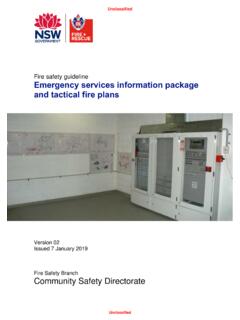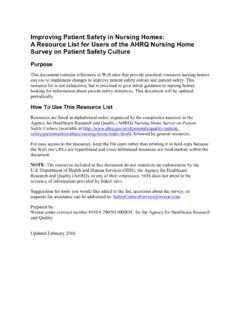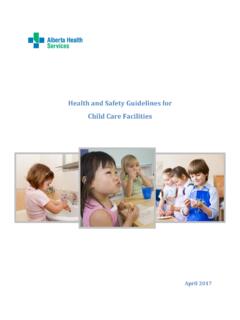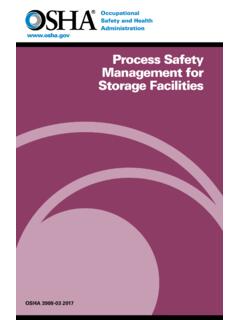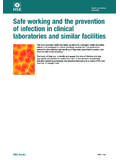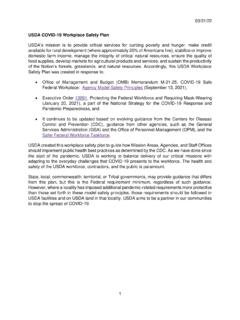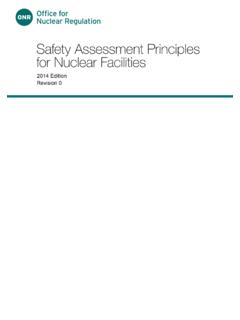Transcription of Fire safety guideline Fire safety in waste facilities
1 Unclassified Unclassified Fire safety guideline Fire safety in waste facilities Version Issued 27 February 2020 Fire safety Branch Community safety Directorate Unclassified Fire and Rescue NSW Fire safety guideline Fire safety in waste facilities 2 Version Issued 27 February 2020 Copyright State Govt NSW Unclassified Uncontrolled if printed, copied or emailed. Always check the Fire and Rescue NSW website for the most recent version. State Government of New South Wales 2020 Copyright of material is vested in the Crown of the State of New South Wales and subject to the Copyright Act 1968. Material may be freely reproduced and distributed for personal and non-commercial use. Refer to the copyright notice at While the material is current at the time of writing, any changes after the time of publication may impact on its accuracy. Individuals are responsible for ensuring they have the most current version of this document and to exercise judgement and care with respect to use.
2 The Crown disclaims, to the extent permitted by law, all warranties, representations or endorsements, expressed or implied, and does not warrant that the material herein is free from errors or omissions or is exhaustive. The Crown disclaims any liability (including but not limited to liability by reason of negligence) to users of the material for any loss, damage, cost or expense whether direct, indirect, consequential or special, incurred by, or arising by reason of, any person using or relying on the material and whether caused by reason of, any error, omission or misrepresentation in the material or otherwise. Published by Fire and Rescue NSW Community safety Directorate Fire safety Branch Document control File Reference: FRN14/3255 Document ID: D17/81582 Version: Release Date: 27 February 2020 Document history Version Date Authorised by: 01 19 Nov 2018 Assistant Commissioner Fire safety 02 20 Aug 2019 Assistant Commissioner Fire safety * 23 Oct 2019 Chief Superintendent Fire safety * 27 Feb 2020 Chief Superintendent Fire safety * Amendment 1 updated reference to Access for fire brigade vehicles and firefighters Amendment 2 updated Environmental Planning and Assessment Regulation 2000 references Unclassified Fire safety guideline Fire and Rescue NSW Fire safety in waste facilities Version Issued 27 February 2020 3 Copyright State Govt NSW Unclassified Uncontrolled if printed, copied or emailed.
3 Always check the Fire and Rescue NSW website for the most recent version. Contents 1 Purpose 4 2 Scope 4 3 Application 4 4 Definitions 5 5 Background 7 6 Legislated requirements 8 Protection of the Environment Operations Act 1997 8 Environmental Planning and Assessment Act 1979 8 Work Health and safety Act 2011 9 National Construction Code 9 7 Development and planning 9 General 9 Designing for special hazard 11 Development of existing waste facilities 12 Firefighting intervention 12 Fire hydrant system 13 Automatic fire sprinkler systems 14 Fire detection and alarm systems 14 Smoke hazard management 15 Fire water run-off containment 15 Bush fire prone land 16 8 Facility operation and management 16 General 16 Storage and stockpiles 16 Stockpile movement 17 External stockpiles 18 Internal stockpiles 21 Operations plan 22 9 Workplace fire safety 22 General 22 Risk assessment and mitigation 23 Emergency plan 24 Emergency services information package (ESIP)
4 24 Fire safety statements 25 10 References 25 Appendix A Acceptable solution 27 Unclassified Fire and Rescue NSW Fire safety guideline Fire safety in waste facilities 4 Version Issued 27 February 2020 Copyright State Govt NSW Unclassified Uncontrolled if printed, copied or emailed. Always check the Fire and Rescue NSW website for the most recent version. 1 Purpose The purpose of this document is to provide guidance on fire safety in waste facilities that receive combustible waste material, including adequate provision for fire safety and facilitate safe fire brigade intervention to protect life, property and the environment. 2 Scope This guideline details the requirements of Fire and Rescue NSW (FRNSW) for: a) consideration of fire safety during all stages of a waste facility including site selection, planning, design, assessment and operation b) fire safety systems to be adequate to the special hazards identified within a waste facility and which also meet the operational needs of firefighters c) safe storage and stockpiling of combustible waste material based on expected combustibility and maximum pile size, and d) workplace fire safety and fire safety planning, including procedures for the event of fire or emergency incident.
5 When this guideline is followed the likelihood and severity of fire should be reduced, assisting with firefighting intervention and protecting life, property and environment from fire. 3 Application This guideline applies to any waste facility within NSW involved in the storage, processing or resource recovery of combustible waste material. This guideline applies to any proposed development of a waste facility that involves a change of building use or building work that intends to meet the National Construction Code (NCC). This guideline does not apply to any waste facility, or areas of, that are being used for: a) landfill (but, may apply to a waste facility on the landfill site) b) composting, including in-vessel, green waste and anaerobic digestion c) liquid waste treatment d) hazardous chemicals or special waste treatment ( waste tyres), or e) less than 50 m3 of combustible waste material. Note: Fire safety requirements still apply to waste facilities not covered by this guideline .
6 This guideline does not overrule any other requirement that specifically relates to the business or undertaking ( guidelines for rubber tyre storage, dangerous goods code), nor does this guideline overrule any other specific condition that has been imposed on the waste facility. This guideline is intended to be used by any person conducting a business or undertaking (PCBU), owner, development proponent ( builder, fire engineer), planning/environmental consultant, regulatory authority, consent authority or certifier. This guideline is not a statutory document and should be given due consideration by each stakeholder as it relates to their role and responsibility in operating, managing, planning, designing, consulting, assessing or determining the case of any applicable waste facility. Unclassified Fire safety guideline Fire and Rescue NSW Fire safety in waste facilities Version Issued 27 February 2020 5 Copyright State Govt NSW Unclassified Uncontrolled if printed, copied or emailed.
7 Always check the Fire and Rescue NSW website for the most recent version. This guideline is developed in the public interest and should be taken into consideration by any consent authority when determining a development application for a waste facility (refer to Section (1)(e) of the Environmental Planning and Assessment Act 1979 (EP&A Act)). Note: Under Section of the EP&A Act, the consent authority may impose requirements from this guideline (in part or full) as a condition on the development consent. Where appropriate, it is recommended that an external consultant be engaged to provide specialist advice and services on the application of this guideline to any given waste facility. 4 Definitions The following definitions apply in this guideline : acceptable solution means a prescriptive solution as defined in Appendix A. certifier means a council or an accredited certifier who holds a certificate of accreditation as an accredited certifier under the Building Professionals Act 2005.
8 Consent authority means the same as in Section of the EP&A Act. combustible waste material means any solid waste material that can readily ignite and burn under normal conditions, which includes: paper and cardboard wood and wood-based products plastic rubber textiles waste derived fuels such as refuse derived fuels (RDF), solid recovered fuels (SRF) and processed engineered fuels (PEF) metal with combustible contaminants, and any other waste material which may pose a notable fire risk like above. Department Planning, Industry and Environment (DPIE) means the consent authority responsible for State Significant Development under Division of the EP&A Act. emergency plan means a written plan which details the actions required to be undertaken by occupants of a premises during a fire or other emergency incident. emergency response procedures means written procedures outlining the response to an emergency, such as evacuation and/or activation of the emergency response team etc.
9 Emergency services information package (ESIP) means a folder containing concise information necessary to allow emergency services to commence operations and develop effective strategies and tactics to manage a fire or other emergency incident. fire brigade means a statutory authority constituted under an Act of Parliament having as one of its functions, protect life and property from fire and other emergencies. fire brigade booster assembly means a connecting device enabling the fire brigade to pressurise or pump water into a fire hydrant or fire sprinkler system. fire brigade station means a state government operated premises which is a station for a fire brigade ( a FRNSW or NSW Rural Fire Service fire brigade station). Unclassified Fire and Rescue NSW Fire safety guideline Fire safety in waste facilities 6 Version Issued 27 February 2020 Copyright State Govt NSW Unclassified Uncontrolled if printed, copied or emailed.
10 Always check the Fire and Rescue NSW website for the most recent version. fire brigade vehicle means any vehicle that forms part of the equipment of a fire brigade and that is equipped with an audible warning device and flashing lights. fire compartment means the same as in the NCC. fire hydrant means an assembly installed on a mains water or private water pipeline, which provides a valved outlet to permit a supply of water to be taken for firefighting. fire safety system means an active and/or passive system which warns people of an emergency, provides safe evacuation, restricts or extinguishes fire. fire-source feature means: a) the far boundary of a road, river, lake or the like adjoining the premises; or b) a side or rear boundary of the premises; or c) an external wall of another building which is not a Class 10 building. fire water run-off means residual water used in fighting the fire, which is contaminated with the products of combustion and unburnt materials washed off fire debris.




